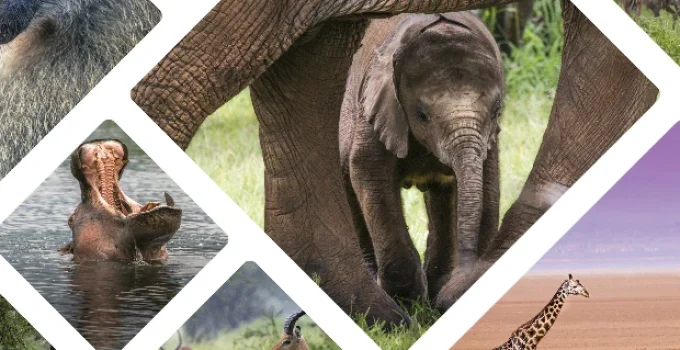⛏️Break It Down
- What Is a Mammal?
- Do All Mammals Have Hair?
- Why Do Mammals Produce Milk?
- Are All Mammals Warm-Blooded?
- What Are the Types of Mammals?
- Traits of Mammals Chart
- 🎯 Final Thoughts
- 📚 References
What Makes an Animal a Mammal?
Mammals are a group of animals known for three special traits: they have hair or fur, produce milk for their young, and are warm-blooded. These features help scientists tell mammals apart from reptiles, birds, fish, and amphibians.
From tiny mice to massive whales, all mammals share these traits—even if they look very different. Let’s explore what makes this animal group so unique!
🐘 According to the Journal of Mammology, there are over 6,399 species of mammals on Earth today!
What Is a Mammal?
A mammal is a vertebrate, which means it has a spine or backbone. Mammals are part of the animal class Mammalia, and they usually share these characteristics:
- Hair or fur at some point in their life
- Mammary glands that produce milk
- Three middle ear bones
- Warm-blooded (endothermic)
- Lungs for breathing
Even mammals that live in water, like dolphins and whales, must come to the surface to breathe air. They also nurse their babies and have hair when they’re born.
🧬 Mammals were once reptiles? According to Britanicca, mammals were evolved from members of reptilian order Therapsida about 252 million years ago.
Do All Mammals Have Hair?
Yes—every mammal has hair or fur, though some have less than others. Hair helps mammals:
- Stay warm
- Camouflage
- Sense the world (like whiskers!)
- Communicate with others
Some animals, like whales and dolphins, have just a little hair when they’re born. Humans are mammals too—and our hair grows on many parts of our bodies.
🦁 According to the American Museum of Natural History, some mammals change color to camoflauge themselves with the seasons like the arctic fox that is brown in the summer and white in the winter!
Why Do Mammals Produce Milk?
This is one of the most important features of mammals: female mammals have special glands that make milk. These are called mammary glands, and they give the mammal group its name.
Milk gives babies everything they need to grow:
- Nutrients
- Fat
- Water
- Immune protection
No other animal group does this—not reptiles, birds, or fish.
🍼 According to the journal Nutrients, mother’s milk modifies the function of the gastrointestinal tract and the immune system, as well as in brain development.
Are All Mammals Warm-Blooded?
Yes! Mammals are warm-blooded, or endothermic, which means they:
- Keep a steady body temperature no matter the weather
- Burn energy to stay warm
- Use fur, fat, or behavior to hold in heat
This helps mammals live in almost every environment on Earth—from deserts to icy oceans!
🌡️ According to the Natural History Museum, some mammals like the saiga and bearded seal have built in heating and cooling systems in their noses!
What Are the Types of Mammals?
There are three major types of mammals, based on how they give birth and raise their young:
| Type | Example Animals | Special Trait |
|---|---|---|
| Monotremes | Platypus, echidna | Lay eggs but still produce milk |
| Marsupials | Kangaroo, opossum, koala | Young are born early and grow in a pouch |
| Placentals | Dogs, whales, humans | Young develop inside the mother’s womb |
Monotremes are the only mammals that lay eggs, but their babies still drink milk from the mother. Marsupials carry their babies in pouches, while placentals give birth to fully formed young after longer pregnancies.
🦘 According to Australia’s National Science Agency, marsupial babies are born after only one month before they have even developed eyes or hind legs! They are only the size of a jellybean and must crawl to the pouch!
Traits of Mammals Chart
Here’s a simple chart to show what makes mammals stand out:
| Mammal Trait | Do Mammals Have It? | Why It Matters |
|---|---|---|
| Hair or Fur | ✅ Yes | Helps with warmth, camouflage, and senses |
| Mammary Glands | ✅ Yes | Allows mothers to feed their babies |
| Warm-Blooded | ✅ Yes | Keeps body temperature stable |
| Lungs | ✅ Yes | All mammals breathe air |
| Backbone (Vertebrate) | ✅ Yes | Supports body and protects spinal cord |
🎯 Final Thoughts
So, what makes an animal a mammal? It all comes down to a few important traits: they have hair or fur, produce milk for their babies, and are warm-blooded. Whether they live in trees, oceans, deserts, or our homes, mammals are one of the most diverse and fascinating animal groups on the planet. Next time you see your dog, cat, or even yourself in the mirror—you’re looking at a mammal!
📚 References
📝Connor J Burgin, Jocelyn P Colella, Philip L Kahn, Nathan S Upham, How many species of mammals are there?, Journal of Mammalogy, Volume 99, Issue 1, 1 February 2018, Pages 1–14, https://doi.org/10.1093/jmammal/gyx147
💻Britannica. Mammal – “Evolution, Classification, Adaptations.” https://www.britannica.com/animal/mammal/Evolution-and-classification
💻American Museum of Natural History. Camouflage. https://www.amnh.org/explore/ology/ology-cards/187-camouflage
📝Martin, Camilia R et al. “Review of Infant Feeding: Key Features of Breast Milk and Infant Formula.” Nutrients vol. 8,5 279. 11 May. 2016, doi:10.3390/nu8050279
💻Natural History Museum. “Six Fascinating Ways Animals Survive the Cold.” https://www.nhm.ac.uk/discover/ways-animals-survive-cold.html
💻Commonwealth Scientific and Industrial Research Organisation. “Quick Facts about Marsupials.” https://www.csiro.au/en/news/All/Articles/2017/January/quick-facts-marsupials
📌Learn More About Mammals
- When Do Squirrels Hibernate? 🐿️How These Smart Survivors Outsmart Winter
- Do All Mammals Have Fur? 🦭 The Fuzzy Facts Behind Mammal Life
- What Does Warm-Blooded Mean? 🌡️ Animals That Bring the Heat (Literally)
- Which Mammals Lay Eggs? 🥚 The Eggstraordinary Rule-Breakers of the Mammal World
- Do Marine Mammals Breathe Underwater? 🐬 Explore How They Survive in the Sea
